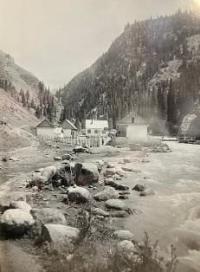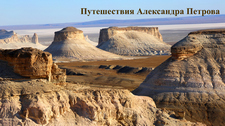You are here
First resorts in Kyrgyzstan.

Travel and tours in nature of Kyrgyzstan.
"Near Usha (now Osh) the air is delightful, running water is abundant, the spring is charming. In all of Fergana there is no city like Usha in terms of pleasantness and climate"
Sultan Babur (1483 – 1530).
Tourism in Kyrgyzstan and Central Asia.
The earliest information about the use of medicinal resources on the territory of modern Kyrgyzstan dates back to the IInd – IIIrd centuries. During this period, one of the first temporary settlements spontaneously formed at the mineral springs in the Issyk-Ata gorge, where people sought to recover from various ailments.
Later, a similar place of health improvement arose near the modern city of Jalal-Abad. According to popular legend, the numerous mineral springs of this region healed the holy prophet Ayub (Job). According to V.V. Bartold (1900), "the grave (of Job) ... in Fergana (today - the healing springs of Khazret-Ayub, located two miles from the village of Jelalabad) was known to Makdisi (946 - 1000)".
Pilgrims from all over Central Asia (now Central Asia), as well as from Afghanistan, China and India, came here, hoping to be cured of various diseases. One of the examples of well-appointed facilities of this type in the past is the description of P.P. Semenov Tien-Shansky, given in his work "Journey to the Tien Shan in 1856 - 1857" (chapter four). In it he says:
"The sun had already set behind the mountains when we reached the famous spring at about seven o'clock in the evening, where we stopped for the night. The entrance to the Arasana pool was closed by wooden doors, on which Tibetan inscriptions were still preserved, similar to those we saw at Tamgaly-Tash, located thirty miles below the Ili picket.
A warm spring, emerging from underground, filled a spacious pool two meters long, one meter wide and also about a meter deep, lined with granite. Its temperature was 40°C. The spring had a sulfuric smell, but no gas emission was observed - there were no bubbles on the surface.
Their exit was probably hindered by the rubble at the bottom of the pool, among which the place where the spring came out was not visible. A stream several meters long flowed out of the pool, flowing into the Ak-Su River. This rapid river rushed through the gorge, making its way between huge stones, foaming and forming waterfalls.
At seven o'clock in the evening, the water temperature in the river was 11°C with an air temperature of 15°C. According to the results of hypsometric measurements, the altitude of our camp above sea level was 1810 meters." Early medical structures were dug at the site of the spring, covered with a canopy of branches, into which the healing water flowed.
Patients were located nearby - either in the open air or in yurts they brought with them. Over time, capital buildings and caravanserais began to be erected near the springs, such as in Issyk-Ata, Osh, Jalal-Abad and other places. If the springs were located in accessible areas, settled settlements often arose near them.
Thus, V. Bartold (1891) mentions the ruins of the Kabalbulak settlement on the Aksu River, located "approximately 2.5 versts above the Belovodskaya station (the modern settlement of Belovodskoye)." He notes that "Kabal-Bulak" is the name of a group of springs flowing out of the mountain near the ruins.
The taste of water can be used to judge the presence of mineral impurities in it. Thus, mineral springs were among the first natural healing sites to be developed. Their importance is confirmed by one of the first written testimonies about Kyrgyzstan – the description of Captain P.Iv. Rychkov in his work “Daily notes of the journey of Captain Petr Rychkov in the Kirghiz-Kaisak steppe” (1771). In it he wrote:
“Uly-Tau and Ala-Tau are two different mountains located in the Kirghiz-Kaisak steppe. The first means “high”, the second – “motley” mountain. ... This mountain is notable for its numerous hot springs gushing from its foot”. The healing effect of the mountain climate was noted as early as the Middle Ages.
In the XVth century, Sultan Babur (1483 – 1530) wrote: “The air near Usha (modern Osh) is delightful, there is an abundance of running water, the spring is charming. In all of Fergana there is no city comparable to Usha in the mildness of its climate” [cit. 100, p. 112].
Indeed, the ancient city of Osh, which has existed for over three thousand years and is located in the highland part of the Oshkarasu oasis, has a climate that compares favorably with the surrounding areas. It can be assumed that it was the favorable climatic conditions that contributed to the emergence of the largest pilgrimage center in Kyrgyzstan - the mazar on Mount Takht-i-Suleiman (Solomon's throne) near Osh.
It was believed that thanks to the sacred relics, believers could be healed from ailments here (P.6.5, Fig. 1. XII century). One of the descriptions (Asian Russia. Vol. 2. "Land and Economy", Publishing House of the Resettlement Administration, 1914) says that "many Muslim pilgrims flock here, seeking to be healed by touching various cracks, depressions and stones, each of which is credited with the ability to cure certain diseases."
In the process of development of climatic and balneological complexes, the first architectural objects for recreational purposes began to appear. Their formation occurred under the influence of both natural and climatic and social factors, which determined both common features and differences between individual types of these structures.
The founders of the first resort institutions (sanitary stations) were district Russian doctors, who laid the scientific basis for studying the influence of natural and climatic conditions on human health. Thus, doctor V. Vyshpolsky wrote in one of his works (1895):
- "Although the warm springs of Issyk-Kul have undoubted healing properties, they are little known in the Semirechye region and are therefore rarely visited. This is due, in particular, to the high cost of travel and the lack of entertainment. In Europe, such springs, thanks to their picturesque location, mountain air and healing properties, would attract thousands of patients, but here, if two dozen visitors are gathered, the season is already considered busy." V. Vyshpolsky played a key role in the establishment of the first balneological stations based on the unique mineral springs in the Jety-Oguz and Aksu gorges, thereby laying the foundation for their further development in Kyrgyzstan.
The first recreational facility was created in 1887 near the city of Jalal-Abad, at the Khazret-Ayub mineral springs (now the Jalalabat springs). The history of its formation is a typical example of the development of similar resort institutions during that period.
The famous geographer and geologist I. Mushketov conducted research on the thermal springs, and in 1883 the Russian doctor I. Bunin published "Notes on the Jalal-Abad-Ayub Waters". They emphasized the importance of these waters for therapeutic purposes and the need for their radical improvement:
- "With 50 baths, 600 people will be able to use the Ayub waters at the same time... Treatment is possible from April 15 to October 15, and if there are insulated rooms - throughout the year." However, according to eyewitnesses, from 1887 to 1893, only 351 people used the waters as private patients, which is about 50 people per season. "There are no barracks for them... Untimely and chaotic repairs only with difficulty prevent the destruction of the springs".
The functioning of the facility was maintained by organizing a sanitary and hygienic station for military officials for 45 people. Two barracks were built for them - one for 5 people, the other for 40. Among other visitors to the resort, officials and representatives of the local nobility predominated.
The Issykata station, the construction of which began in 1891 under the auspices of the Red Cross Administration, developed in a similar way. Previously, there was a caravanserai here, which served as a hotel for pilgrims arriving from different parts of Central Asia, as well as pits filled with mineral water, used as baths.
By 1903, 5 barracks with two rooms each and one common barrack with 5 rooms were built with the Society's funds. The reservoirs of the springs were faced with hewn stone on Portland cement and covered with wooden structures. However, the capacity of all the capital structures of the balneological station did not exceed 30 people, and the seasonal increase in the number of visitors was ensured by installing several yurts.
The patients were predominantly military personnel, the bourgeoisie and merchants. In 1890, doctors proposed methodologically important recommendations for organizing sanitary and hygienic stations in Osh, Uchkurgan, the Alai Valley and Semirechye. It was emphasized that for this it was necessary to "select a suitable location in the mountains and adapt it in such a way that it would be possible to live in comfort and without deprivation."
At that time, health recovery facilities played an important role in the adaptation of settlers and military personnel who arrived from various regions of Russia and Ukraine. The mountain air and surrounding landscape helped them recover from the impact. unusual hot and dry climate of the valleys, helping to cope with meteorological diseases.
Thus, the first recreational facilities in Kyrgyzstan were sanitary-hygienic and balneological stations. The former were located in the foothills, mountain gorges and elevated areas, where the climate was cooler in summer than on the plains. The latter were built near sources of mineral healing waters.
Often both types were combined in one place, as, for example, in Jalalabat and Jetyoguz. These institutions served mainly the military and representatives of the local nobility, having a limited capacity (30 - 50 people), and access for the general population was virtually impossible.
The construction of such facilities was chaotic and primitive: there were no convenient communication routes, water supply and sewerage. At the same time, the pre-revolutionary period laid the scientific foundation for balneology, contributed to research and the first attempts to improve balneological facilities.
However, the architecture of the first resorts remained barracks-type, without any particular aesthetic value. After the October Revolution, the resort business in the USSR came under state control, and its development began to focus on the principle of "resorts for workers". Already in 1919, all resort institutions in Kyrgyzstan were nationalized.
In 1927, a joint-stock company was created to expand state resort construction, which included the People's Commissariats of Health of the Kyrgyz, Uzbek and Kazakh Republics. Of the 62 resort facilities under the jurisdiction of this organization, five were located on the territory of Kyrgyzstan (Aksu, Jalalabat, Jety-Oguz, Issykata, Issyk-Kul), which was assigned a leading role in the development of the resort infrastructure of the region.
In addition to the reconstruction of existing facilities, the construction of new resort institutions began on the basis of engineering surveys and design developments. In 1930, the Koysary resort, designed for 250 people, was opened on the coast of Issyk-Kul.
After the establishment of the Resort Administration of Kyrgyzstan in 1931, the process of systematic construction of health resorts continued, and their specialization expanded. The first rest homes appeared, such as "Tamga", "Issyk-Kul" (Aurora) on Issyk-Kul and "Named after the 20th Anniversary of Soviet Kirgizia" near Frunze.
By 1940, more than 5,000 people were treated annually at the four largest resorts of Kyrgyzstan (Jalal-Abad, Issykata, Jety-Oguz and Koysary). The growth in their capacity was caused not only by the increase in demand among residents of the republic, but also by the desire to meet the needs for rest and treatment of workers from other regions of the Soviet Union..
Authority:
https://foto.kg/galereya/4135-vid-na-kurort-dzhety-oguz.html
Smirnov Yu.N. "Theory of Architecture: Features of the Formation of the Architectural Environment of the Mountainous Regions of Kyrgyzstan". Bishkek. Publishing house KRSU, 2015.
https://arch.kyrlibnet.kg/uploads/KRSUSMIRNOVYU.N.%203.pdf







